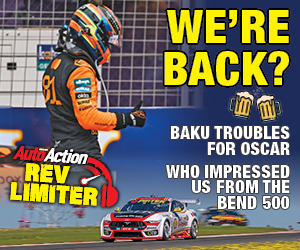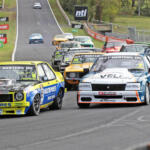AA Archives: The mystery of Moffat’s stolen Falcon, Ambrose’s historic hat-trick and more
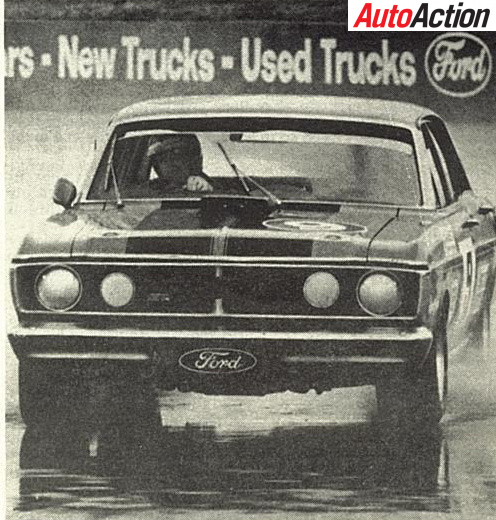
By Thomas Miles
Date posted: 27 June 2023
Take a journey back in time and discover what was making motorsport news around the world in this fortnight over the last five decades as AUTO ACTION delves into its archives.
1973 – Brock wins amid the ‘great Ford robbery’

The cover of AUTO ACTION #62 had plenty of news including Bob Watson’s surprise move to the Holden Dealer Team in the Victorian Rally Championship.
Whilst Peter Brock overcame treacherous conditions to win ATCC’s trip to Adelaide, all the talk was about what happened to Allan Moffat.
Despite Brock crossing the line at near walking pace in heavy rain, he won by over a lap from Moffat, who was proclaimed as the “hero” for driving a borrowed Murray Carter Falcon in second.
Amazingly Moffat had to contend with the strange problem of his race car being stolen at 3am on raceday morning.
“Moffat’s car was stolen from B.S. Stillwell’s Medindie premises in the early hours of raceday,” read the AA issue #62 report by Rob Trenorden.
“At around 3am it is believed two men broke into the car workshop, started the car and when an irate neighbour arose to complain of the noise, they left.
“The men returned a short time later, refuelled the car and drove away in the rain, ironically on wet weather tyres fitted for the last session of practice.
“There was no word on the car by noon on Sunday and Carter’s Ford was offered to Moffat.
“The missing vehicle was subsequently discovered on the following Tuesday afternoon abandoned and bogged, but otherwise unharmed on a muddy track in the Adelaide Hills some 14 miles from the city.”
As “nobody could quite believe the early morning news” Moffat was given some exploratory laps prior to the race where he started at the back of the 18-car grid.
As Brock led away from pole, Moffat “gobbled up the Toranas” to surge to eight by the end of the straight.
With the Ford star on the charge, Brock also put the foot down and set near record pace to build a 10s advantage.
If Moffat’s weekend could not get any more dramatic, he was forced to make an unscheduled stop to fix a loose exhaust.
This dropped the Ford star back towards the rear end in 12th, but he once again fought his way back to second despite nearly spinning close to the finish.
Brock crawled across the line in front of over 10,000 fans being hampered by a sticking throttle which was an experience “would not like to go through again.”
1983 – Moffat creeps closer to ATCC title
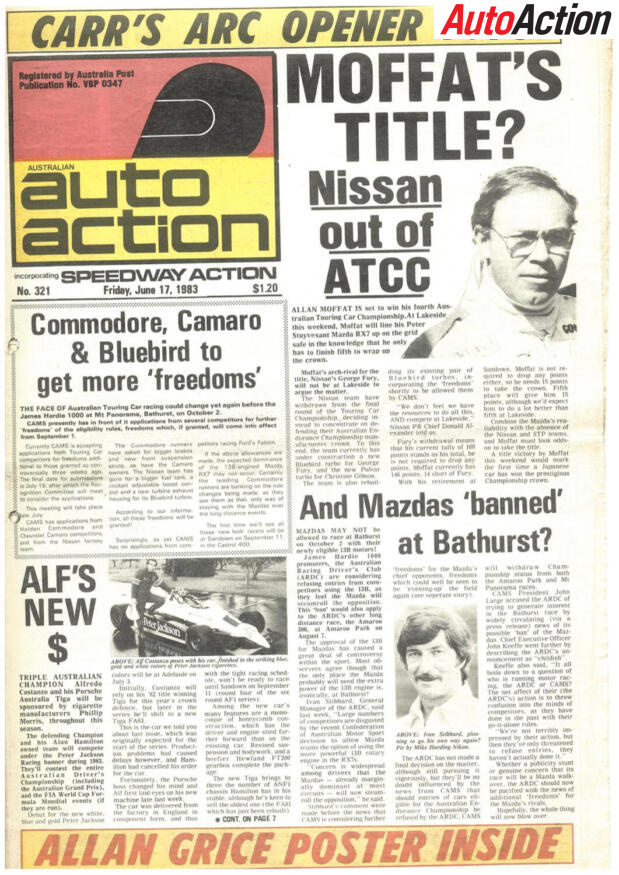
Regulations around the Mazdas, Commodores, Camaros and Bluebirds were front page news in 1983.
Allan Moffat was on the verge of winning his fourth ATCC crown as the series headed to Lakeside.
However, his dominant Mazda RX7 faced the prospect of being banned from that year’s Bathurst 1000.
Race promoters, the Australian Racing Drivers Club were considering refusing entries using the 13B engine, which was under the bonnet of Moffat’s Mazda.
“Mazdas may not be allowed to race at the Bathurst 1000 with their new 13B motors!” Read the front page story.
“James Hardie 1000 promoters, the Australian Racing Driver’s Club are considering refusing entries using the 13B as they feel the Mazda will steamroll the opposition.
“The approval of the 13B for Mazdas has caused a great deal of controversy within the sport.”
In further changes, the Commodore, Camaro and Bluebird cars were anticipated to receive more “freedoms” for the Great Race.
Both Holden and Camaro runners hoped for bigger brakes and new front suspension, while the Nissan factory squad wanted a larger fuel tank.
1993 – RIP James Hunt

The sudden news of James Hunt’s passing made the front page for issue #579 as did the Surfers Paradise street race being threatened by the government demanding $11 million of guarantees.
The motorsport world was saddened by the sudden passing of 1976 world champion James Hunt.
The flamboyant racing driver and personality died of a heart attack just two days after the Canadian Grand Prix won by Alain Prost.
Hunt had commentated on that race for the BBC and wrote a column which appeared in issue #579 of AUTO ACTION where he declared his enjoyment of the recent race and his concern the governing body, FISA was more concerned about politics than bringing F1 back to the “halcyon days of the mid 70s”.
“Though it tended to be processional, I found the Canadian Grand Prix thoroughly entertaining,” opened Hunt’s column.
“While the intensity of the action in the early laps made them quite thrilling, the last half of the race was equally engrossing.
“What worries me is the way the governing body, FISA, seems to be expending more energy on the political fight to impose change then the much more important long-term goal of creating a set of regulations that will return the style of F1 racing to the halcyon days of the mid-70s when the sport was at its most competitive.”
Back home the future of the Surfers Paradise street race was threatened with the government demanding $11 million of guarantees and Mark Skaife finally scored Holden’s first win of the year at an AMSCAR race at Amaroo Park.
2003 – Ambrose bowls over opposition
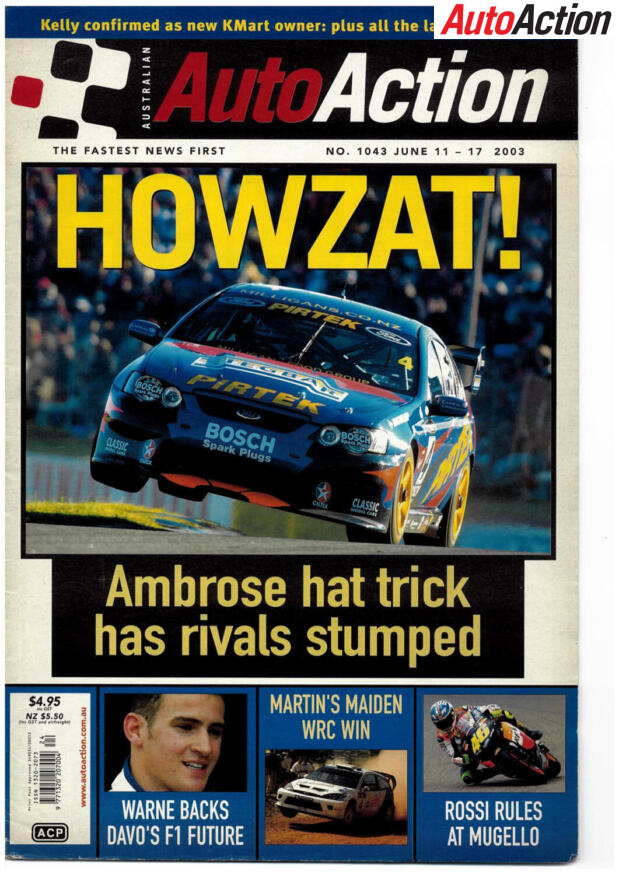
Marcos Ambrose’s Perth performance would have bowled readers over on the front cover of AA issue #1043.
A Marcos Ambrose hat-trick of round wins left the rest of the V8 Supercars paddock stumped following the annual trip to Perth.
Whilst the three races were won by three separate drivers, Ambrose was the only driver to appear on the podium on each occasion to beat Greg Murphy to round honours.
Ambrose was the first Ford driver to take a trifecta since Glenn Seton did it a decade earlier in 1993.
The Stone Brothers Racing driver started an ultra consistent weekend with a solid P3 as Murphy led away from pole position to an opening-race win.
Whilst Mark Skaife claimed race 2, Ambrose followed the #1 HRT Commodore home in second and continued his improving trend by taking out the final race.
The final race win was orchestrated by a fast start and quick work in the pits by the SBR crew as Skaife struggled off the line.
It was not such a successful weekend for SBR teammate Russell Ingall, who bogged it in the sand at the end of Turn 1, while Steven Ellery finished his weekend on the roof at the same corner.
After scoring his first win and ultimately only race win in any category at Wanneroo Raceway, Ambrose was bullish about the future.
“Can you believe the car we had here compared to the car we had here last year,” he said post win.
“We made huge gains and credit to the SBR crew, the car at the end was a real weapon.
“We have pretty much unlocked the code of the BA I guess you could say.”
In a further glimpse to the future, America was already on Ambrose’s mind as it was revealed in the Perth paddock he will travel to the USA later in the year to watch the action at Bristol.
Ambrose said it was simply down to interest, but did expand on his wish to go racing in America once he won the Supercars title.
“I just want to go and see the biggest motorsport series in the world,” he said at the time.
“Im really interested to have a look at NASCAR. I would love to have a go as long as it did not jeopardise what I am doing here.
“My own career is more important than some Yank. That is not the priority right now. I just want to win the V8 championship.”
Italian manufacturers win big

Michael Schumacher leads Ralf Schumacher and Juan Pablo Montoya, through the hairpin at Circuit Gilles-Villeneuve. Photo by LAT Images
Another driver on a tear was Michael Schumacher, whose fourth win in five races at Canada sent him into the championship lead for the first time.
Schumacher drove Ferrari to glory again in a tense Canadian Grand Prix, holding off brother Ralf by just 0.7s.
Although it was another victory for the eventual seven-time world champion and his sixth at Montreal, it was far from his easiest.
“Michael did a very good job of controlling the race despite brake wear problems right from the early stages,” revealed Ferrari technical boss Ross Brawn.
“We breathed a sigh of relief when we got to the chequered flag! The stranger worked well, but the deciding factor was the way Michael drove.”
Driving for Jaguar, Mark Webber finished a lap down, but got his third points finish in the space of four races.
It was also party time for the famous red team that goes racing on two wheels as Loris Capirossi claimed Ducati’s first MotoGP victory at Catalunya.
The Italian held off compatriot Valentino Rossi by 3s with Sete Gibernau joining them on the podium.
Capirossi’s Ducati teammate Australian Troy Bayliss was 10th, while a 17-year-old Casey Stoner crashed in the 125cc race won by Dani Pedrosa.
2013 – Wild action in Darwin

The silly season was in full swing on issue #1547 as Supercars went to Darwin a decade ago.
A decade ago the 2013 Supercars season headed to Darwin where the rivalry between Triple Eight and Ford Performance Racing continued and carnage unfolded.
The weekend started in familiar fashion as Jamie Whincup extended his championship lead by securing his sixth win of the last seven races and first in the short-lived 60/60 Sprint format.
Despite being yet another Whincup win, it was not a smooth ride for the reigning champion, who got the superior jump off the start-line to beat pole sitter David Reynolds into Turn 1.
But a slip up at Turn 6 allowed the #55 FPR Bottle-O Falcon to slip by and take the honours at halftime.
Whincup admitted “we just did not have the pace” in the first half, but made up for it by securing victory by hanging tough around the outside of Reynolds after the 2×2 rolling restart.
But further back the hairpin turned into a major hot spot.
The likes of Craig Lowndes, Garth Tander, Will Davison, James Courtney, Mark Winterbottom, Alex Premat and Tim Blanchard all got tangled up in the tight left-hander where Davison was spun and got pushed around.
Later on the Ford fight for second ended in tears when Winterbottom spun out Reynolds, which suddenly created a sea of Commodores at the front.
Whincup led home Shane van Gisbergen, Courtney and Jonathon Webb, while Rick Kelly (Nissan) and Tim Slade (Mercedes) both finished ahead of the top Ford which was rookie Chaz Mostert.
Ford struck back on Sunday where Winterbottom dominated the second race of the weekend, winning by 6s from Courtney and Lowndes.
Despite being shortened by a red flag, the final race of the weekend was one to remember.
As Reynolds beat Lowndes in the charge through Turn 1, it was bedlam behind as cars flew every which-way on the approach to the following left-right kink.
The major incident was sparked when Slade spun across the track after contact with Jason Bright and into the armco taking David Wall with him.
This caused a chain reaction as Lee Holdsworth collected his teammate, while James Moffat hit the rebounding Wall Commodore and Dean Fiore ended up momentarily on his side against the tyre barrier with Russell Ingall and Premat for company.
Once racing eventually resumed following the lengthy stoppage there was still plenty going on.
Whincup fell to 19th due to a penalty for spinning the wheels in pit lane, while Courtney ground to a halt with an electrical issue.
But all eyes were on the fight for first as Winterbottom hunted down Lowndes in a finish for the ages.
“Frosty” had strong late-race pace to close a 1.9s gap to nothing within the final five laps.
In what was a grandstand finish, Winterbottom was all over the back of Lowndes with the crowd on their feet.
Despite Winterbottom’s best efforts, Lowndes held on by a tenth with Reynolds rounding out the podium.
“I burnt the rears up pretty badly and I could see ‘Frosty’ coming,” Lowndes recalled.
“One more lap and I would have done it,” Winterbottom said.
Off the track the Supercars silly season kicked into gear with rumours circulating around big name free agents Davison, Courtney and Scott McLaughlin.
The biggest chat surrounded Davison as he awaited clarification on the “Blue Oval’s” future involvement with the team.
After winning just one of the first 19 races of the season, Davison made it clear he wanted to stay as speculation began, but he would eventually move to Erebus.
For Courtney he claimed even a return overseas was still a possibility stating “everything is an option” while many wanted McLaughlin following his stunning start to his rookie Supercars season with GRM.
Although Walkinshaw was believed to have been chasing McLaughlin hard as a replacement for Ingall, he stayed loyal to GRM, while Courtney stayed in Australia and at HRT.
Tragedy at Le Mans

Tom Kristensen, Loic Duval and Allan McNish cross the line to win the 2013 Le Mans 24 Hours.
The 2013 24 Hours of Le Mans was filled with sadness after the tragic passing of former Supercars racer Allan Simonsen.
After taking the LMGTE class lead, Simonsen lost traction on the kerb exiting Tetre Rouge corner and collided head-on with the wall just nine minutes into the race.
After being extracted from the car, the popular Dane tragically passed away aged 34 at the medical centre.
The race continued and was all about Audi. After the German brand locked out the top three starting positions on the grid, pole sitters Allan McNish, Tom Kristensen and Loic Duval went on to secure glory.
But they did not have it all their own way, winning by just a lap ahead of the leading Toyota driven by Anthony Davidson, Stephane Sarrazin and Sebastien Buemi.
For more of the latest motorsport news, pick up the latest issue of AUTO ACTION.
PODCAST: The latest episode of the Auto Action RevLimiter podcast is out now!
In the latest podcast, we discuss the heated action in Darwin, the Canadian Grand Prix and more.

AUTO ACTION, Australia’s independent voice of motorsport
Recent Stories
array (
0 =>
WP_Term::__set_state(array(
'term_id' => 19,
'name' => 'About AA',
'slug' => 'about-aa',
'term_group' => 0,
'term_taxonomy_id' => 19,
'taxonomy' => 'category',
'description' => '',
'parent' => 0,
'count' => 58,
'filter' => 'raw',
'cat_ID' => 19,
'category_count' => 58,
'category_description' => '',
'cat_name' => 'About AA',
'category_nicename' => 'about-aa',
'category_parent' => 0,
)),
1 =>
WP_Term::__set_state(array(
'term_id' => 37,
'name' => 'F1',
'slug' => 'f1',
'term_group' => 0,
'term_taxonomy_id' => 37,
'taxonomy' => 'category',
'description' => 'An Introduction to Formula One (F1)
Formula One, or F1, is the highest class of single-seater auto racing, governed by the Fédération Internationale de l\'Automobile (FIA) and is owned by Liberty Media. The name "Formula One" refers to the set of rules or formula that all cars and drivers must comply with.
The F1 season consists of a series of races, known as Grands Prix, held on purpose-built circuits or public roads around the world. The results of each race are combined to determine two annual championships: one for drivers and one for constructors (teams).
The history of Formula One can be traced back to the pre-war Grand Prix racing, which featured open-wheel cars with supercharged engines. The first World Championship of Drivers was organised by the FIA in 1950, following the end of World War II. The first race was held at Silverstone, England, and was won by Giuseppe Farina, driving an Alfa Romeo. The first constructors\' championship was introduced in 1958 and was won by Vanwall.
Formula One has seen many changes and innovations over the years, both in terms of technology and regulations. Some of the most notable developments include the introduction of rear-engined cars in the late 1950s, the use of aerodynamic wings in the late 1960s, the adoption of turbocharged engines in the late 1970s, the emergence of electronic driver aids in the late 1980s, the switch to V10 and then V8 engines in the 1990s and 2000s, and the introduction of hybrid power units in 2014.
Formula One has also produced some of the greatest drivers and rivalries in the history of motorsport. Some of the most famous names include Juan Manuel Fangio, Jim Clark, Jackie Stewart, Niki Lauda, Ayrton Senna, Alain Prost, Michael Schumacher, Lewis Hamilton, and Sebastian Vettel. Some of the most intense battles for the championship have been between Fangio and Stirling Moss in the 1950s, Lauda and James Hunt in the 1970s, Senna and Prost in the late 1980s, Schumacher and Mika Hakkinen in the late 1990s, and Hamilton and Vettel in the 2010s.
Formula One is widely regarded as the pinnacle of motorsport, attracting millions of fans and viewers worldwide. The sport is also a huge business, involving billions of dollars in revenue and expenditure. The teams compete for prize money, sponsorship deals, and media rights, while the drivers earn millions of dollars in salaries and endorsements. The sport is also influenced by politics, regulations, and controversies, such as doping scandals, espionage cases, safety issues, and environmental concerns.
The following is a list of all F1 World Drivers Champions by year, from 1950 to 2020:
1950-1959
1950: Giuseppe Farina (Italy) - Alfa Romeo 158, Alfa Romeo
1951: Juan Manuel Fangio (Argentina) - Alfa Romeo 159, Alfa Romeo
1952: Alberto Ascari (Italy) - Ferrari 500, Ferrari
1953: Alberto Ascari (Italy) - Ferrari 500, Ferrari
1954: Juan Manuel Fangio (Argentina) - Maserati 250F, Maserati / Mercedes-Benz W196, Mercedes-Benz
1955: Juan Manuel Fangio (Argentina) - Mercedes-Benz W196, Mercedes-Benz
1956: Juan Manuel Fangio (Argentina) - Ferrari D50, Ferrari
1957: Juan Manuel Fangio (Argentina) - Maserati 250F, Maserati
1958: Mike Hawthorn (United Kingdom) - Ferrari 246, Ferrari
1959: Jack Brabham (Australia) - Cooper T51, Cooper-Climax
1960-1969
1960: Jack Brabham (Australia) - Cooper T53, Cooper-Climax
1961: Phil Hill (United States) - Ferrari 156, Ferrari
1962: Graham Hill (United Kingdom) - BRM P57, BRM
1963: Jim Clark (United Kingdom) - Lotus 25, Lotus-Climax
1964: John Surtees (United Kingdom) - Ferrari 158, Ferrari
1965: Jim Clark (United Kingdom) - Lotus 33, Lotus-Climax
1966: Jack Brabham (Australia) - Brabham BT19, Brabham-Repco
1967: Denny Hulme (New Zealand) - Brabham BT20, Brabham-Repco
1968: Graham Hill (United Kingdom) - Lotus 49, Lotus-Ford
1969: Jackie Stewart (United Kingdom) - Matra MS80, Matra-Ford
1970-1979
1970: Jochen Rindt (Austria) - Lotus 72, Lotus-Ford
1971: Jackie Stewart (United Kingdom) - Tyrrell 003, Tyrrell-Ford
1972: Emerson Fittipaldi (Brazil) - Lotus 72D, Lotus-Ford
1973: Jackie Stewart (United Kingdom) - Tyrrell 006, Tyrrell-Ford
1974: Emerson Fittipaldi (Brazil) - McLaren M23, McLaren-Ford
1975: Niki Lauda (Austria) - Ferrari 312T, Ferrari
1976: James Hunt (United Kingdom) - McLaren M23, McLaren-Ford
1977: Niki Lauda (Austria) - Ferrari 312T2, Ferrari
1978: Mario Andretti (United States) - Lotus 79, Lotus-Ford
1979: Jody Scheckter (South Africa) - Ferrari 312T4, Ferrari
1980-1989
1980: Alan Jones (Australia) - Williams FW07B, Williams-Ford
1981: Nelson Piquet (Brazil) - Brabham BT49C, Brabham-Ford
1982: Keke Rosberg (Finland) - Williams FW08, Williams-Ford
1983: Nelson Piquet (Brazil) - Brabham BT52, Brabham-BMW
1984: Niki Lauda (Austria) - McLaren MP4/2, McLaren-TAG
1985: Alain Prost (France) - McLaren MP4/2B, McLaren-TAG
1986: Alain Prost (France) - McLaren MP4/2C, McLaren-TAG
1987: Nelson Piquet (Brazil) - Williams FW11B, Williams-Honda
1988: Ayrton Senna (Brazil) - McLaren MP4/4, McLaren-Honda
1989: Alain Prost (France) - McLaren MP4/5, McLaren-Honda
1990-1999
1990: Ayrton Senna (Brazil) - McLaren MP4/5B, McLaren-Honda
1991: Ayrton Senna (Brazil) - McLaren MP4/6, McLaren-Honda
1992: Nigel Mansell (United Kingdom) - Williams FW14B, Williams-Renault
1993: Alain Prost (France) - Williams FW15C, Williams-Renault
1994: Michael Schumacher (Germany) - Benetton B194, Benetton-Ford
1995: Michael Schumacher (Germany) - Benetton B195, Benetton-Renault
1996: Damon Hill (United Kingdom) - Williams FW18, Williams-Renault
1997: Jacques Villeneuve (Canada) - Williams FW19, Williams-Renault
1998: Mika Häkkinen (Finland) - McLaren MP4/13, McLaren-Mercedes
1999: Mika Häkkinen (Finland) - McLaren MP4/14, McLaren-Mercedes
2000-2009
2000: Michael Schumacher (Germany) - Ferrari F1-2000, Ferrari
2001: Michael Schumacher (Germany) - Ferrari F2001, Ferrari
2002: Michael Schumacher (Germany) - Ferrari F2002, Ferrari
2003: Michael Schumacher (Germany) - Ferrari F2003-GA, Ferrari
2004: Michael Schumacher (Germany) - Ferrari F2004, Ferrari
2005: Fernando Alonso (Spain) - Renault R25, Renault
2006: Fernando Alonso (Spain) - Renault R26, Renault
2007: Kimi Räikkönen (Finland) - Ferrari F2007, Ferrari
2008: Lewis Hamilton (United Kingdom) - McLaren MP4-23, McLaren-Mercedes
2009: Jenson Button (United Kingdom) - Brawn BGP 001, Brawn-Mercedes
2010-2020
2010: Sebastian Vettel (Germany) - Red Bull RB6, Red Bull-Renault
2011: Sebastian Vettel (Germany) - Red Bull RB7, Red Bull-Renault
2012: Sebastian Vettel (Germany) - Red Bull RB8, Red Bull-Renault
2013: Sebastian Vettel (Germany) - Red Bull RB9, Red Bull-Renault
2014: Lewis Hamilton (United Kingdom) - Mercedes F1 W05 Hybrid, Mercedes
2015: Lewis Hamilton (United Kingdom) - Mercedes F1 W06 Hybrid, Mercedes
2016: Nico Rosberg (Germany) - Mercedes F1 W07 Hybrid, Mercedes
2017: Lewis Hamilton (United Kingdom) - Mercedes F1 W08 EQ Power+, Mercedes
2018: Lewis Hamilton (United Kingdom) - Mercedes F1 W09 EQ Power+, Mercedes
2019: Lewis Hamilton (United Kingdom) - Mercedes F1 W10 EQ Power+, Mercedes
2020: Lewis Hamilton (United Kingdom) - Mercedes F1 W11 EQ Power+, Mercedes
2021-
2021: Max Verstappen (Netherlands) – Red Bull RB16B, Honda
2022: Max Verstappen (Netherlands) – Red Bull RB18, Red Bull Power Trains Honda
2023: Max Verstappen (Netherlands) – Red Bull RB19, Red Bull Power Trains Honda
2024: Max Verstappen (Netherlands) – Red Bull RB20, Red Bull Power Trains Honda',
'parent' => 660,
'count' => 2912,
'filter' => 'raw',
'cat_ID' => 37,
'category_count' => 2912,
'category_description' => 'An Introduction to Formula One (F1)
Formula One, or F1, is the highest class of single-seater auto racing, governed by the Fédération Internationale de l\'Automobile (FIA) and is owned by Liberty Media. The name "Formula One" refers to the set of rules or formula that all cars and drivers must comply with.
The F1 season consists of a series of races, known as Grands Prix, held on purpose-built circuits or public roads around the world. The results of each race are combined to determine two annual championships: one for drivers and one for constructors (teams).
The history of Formula One can be traced back to the pre-war Grand Prix racing, which featured open-wheel cars with supercharged engines. The first World Championship of Drivers was organised by the FIA in 1950, following the end of World War II. The first race was held at Silverstone, England, and was won by Giuseppe Farina, driving an Alfa Romeo. The first constructors\' championship was introduced in 1958 and was won by Vanwall.
Formula One has seen many changes and innovations over the years, both in terms of technology and regulations. Some of the most notable developments include the introduction of rear-engined cars in the late 1950s, the use of aerodynamic wings in the late 1960s, the adoption of turbocharged engines in the late 1970s, the emergence of electronic driver aids in the late 1980s, the switch to V10 and then V8 engines in the 1990s and 2000s, and the introduction of hybrid power units in 2014.
Formula One has also produced some of the greatest drivers and rivalries in the history of motorsport. Some of the most famous names include Juan Manuel Fangio, Jim Clark, Jackie Stewart, Niki Lauda, Ayrton Senna, Alain Prost, Michael Schumacher, Lewis Hamilton, and Sebastian Vettel. Some of the most intense battles for the championship have been between Fangio and Stirling Moss in the 1950s, Lauda and James Hunt in the 1970s, Senna and Prost in the late 1980s, Schumacher and Mika Hakkinen in the late 1990s, and Hamilton and Vettel in the 2010s.
Formula One is widely regarded as the pinnacle of motorsport, attracting millions of fans and viewers worldwide. The sport is also a huge business, involving billions of dollars in revenue and expenditure. The teams compete for prize money, sponsorship deals, and media rights, while the drivers earn millions of dollars in salaries and endorsements. The sport is also influenced by politics, regulations, and controversies, such as doping scandals, espionage cases, safety issues, and environmental concerns.
The following is a list of all F1 World Drivers Champions by year, from 1950 to 2020:
1950-1959
1950: Giuseppe Farina (Italy) - Alfa Romeo 158, Alfa Romeo
1951: Juan Manuel Fangio (Argentina) - Alfa Romeo 159, Alfa Romeo
1952: Alberto Ascari (Italy) - Ferrari 500, Ferrari
1953: Alberto Ascari (Italy) - Ferrari 500, Ferrari
1954: Juan Manuel Fangio (Argentina) - Maserati 250F, Maserati / Mercedes-Benz W196, Mercedes-Benz
1955: Juan Manuel Fangio (Argentina) - Mercedes-Benz W196, Mercedes-Benz
1956: Juan Manuel Fangio (Argentina) - Ferrari D50, Ferrari
1957: Juan Manuel Fangio (Argentina) - Maserati 250F, Maserati
1958: Mike Hawthorn (United Kingdom) - Ferrari 246, Ferrari
1959: Jack Brabham (Australia) - Cooper T51, Cooper-Climax
1960-1969
1960: Jack Brabham (Australia) - Cooper T53, Cooper-Climax
1961: Phil Hill (United States) - Ferrari 156, Ferrari
1962: Graham Hill (United Kingdom) - BRM P57, BRM
1963: Jim Clark (United Kingdom) - Lotus 25, Lotus-Climax
1964: John Surtees (United Kingdom) - Ferrari 158, Ferrari
1965: Jim Clark (United Kingdom) - Lotus 33, Lotus-Climax
1966: Jack Brabham (Australia) - Brabham BT19, Brabham-Repco
1967: Denny Hulme (New Zealand) - Brabham BT20, Brabham-Repco
1968: Graham Hill (United Kingdom) - Lotus 49, Lotus-Ford
1969: Jackie Stewart (United Kingdom) - Matra MS80, Matra-Ford
1970-1979
1970: Jochen Rindt (Austria) - Lotus 72, Lotus-Ford
1971: Jackie Stewart (United Kingdom) - Tyrrell 003, Tyrrell-Ford
1972: Emerson Fittipaldi (Brazil) - Lotus 72D, Lotus-Ford
1973: Jackie Stewart (United Kingdom) - Tyrrell 006, Tyrrell-Ford
1974: Emerson Fittipaldi (Brazil) - McLaren M23, McLaren-Ford
1975: Niki Lauda (Austria) - Ferrari 312T, Ferrari
1976: James Hunt (United Kingdom) - McLaren M23, McLaren-Ford
1977: Niki Lauda (Austria) - Ferrari 312T2, Ferrari
1978: Mario Andretti (United States) - Lotus 79, Lotus-Ford
1979: Jody Scheckter (South Africa) - Ferrari 312T4, Ferrari
1980-1989
1980: Alan Jones (Australia) - Williams FW07B, Williams-Ford
1981: Nelson Piquet (Brazil) - Brabham BT49C, Brabham-Ford
1982: Keke Rosberg (Finland) - Williams FW08, Williams-Ford
1983: Nelson Piquet (Brazil) - Brabham BT52, Brabham-BMW
1984: Niki Lauda (Austria) - McLaren MP4/2, McLaren-TAG
1985: Alain Prost (France) - McLaren MP4/2B, McLaren-TAG
1986: Alain Prost (France) - McLaren MP4/2C, McLaren-TAG
1987: Nelson Piquet (Brazil) - Williams FW11B, Williams-Honda
1988: Ayrton Senna (Brazil) - McLaren MP4/4, McLaren-Honda
1989: Alain Prost (France) - McLaren MP4/5, McLaren-Honda
1990-1999
1990: Ayrton Senna (Brazil) - McLaren MP4/5B, McLaren-Honda
1991: Ayrton Senna (Brazil) - McLaren MP4/6, McLaren-Honda
1992: Nigel Mansell (United Kingdom) - Williams FW14B, Williams-Renault
1993: Alain Prost (France) - Williams FW15C, Williams-Renault
1994: Michael Schumacher (Germany) - Benetton B194, Benetton-Ford
1995: Michael Schumacher (Germany) - Benetton B195, Benetton-Renault
1996: Damon Hill (United Kingdom) - Williams FW18, Williams-Renault
1997: Jacques Villeneuve (Canada) - Williams FW19, Williams-Renault
1998: Mika Häkkinen (Finland) - McLaren MP4/13, McLaren-Mercedes
1999: Mika Häkkinen (Finland) - McLaren MP4/14, McLaren-Mercedes
2000-2009
2000: Michael Schumacher (Germany) - Ferrari F1-2000, Ferrari
2001: Michael Schumacher (Germany) - Ferrari F2001, Ferrari
2002: Michael Schumacher (Germany) - Ferrari F2002, Ferrari
2003: Michael Schumacher (Germany) - Ferrari F2003-GA, Ferrari
2004: Michael Schumacher (Germany) - Ferrari F2004, Ferrari
2005: Fernando Alonso (Spain) - Renault R25, Renault
2006: Fernando Alonso (Spain) - Renault R26, Renault
2007: Kimi Räikkönen (Finland) - Ferrari F2007, Ferrari
2008: Lewis Hamilton (United Kingdom) - McLaren MP4-23, McLaren-Mercedes
2009: Jenson Button (United Kingdom) - Brawn BGP 001, Brawn-Mercedes
2010-2020
2010: Sebastian Vettel (Germany) - Red Bull RB6, Red Bull-Renault
2011: Sebastian Vettel (Germany) - Red Bull RB7, Red Bull-Renault
2012: Sebastian Vettel (Germany) - Red Bull RB8, Red Bull-Renault
2013: Sebastian Vettel (Germany) - Red Bull RB9, Red Bull-Renault
2014: Lewis Hamilton (United Kingdom) - Mercedes F1 W05 Hybrid, Mercedes
2015: Lewis Hamilton (United Kingdom) - Mercedes F1 W06 Hybrid, Mercedes
2016: Nico Rosberg (Germany) - Mercedes F1 W07 Hybrid, Mercedes
2017: Lewis Hamilton (United Kingdom) - Mercedes F1 W08 EQ Power+, Mercedes
2018: Lewis Hamilton (United Kingdom) - Mercedes F1 W09 EQ Power+, Mercedes
2019: Lewis Hamilton (United Kingdom) - Mercedes F1 W10 EQ Power+, Mercedes
2020: Lewis Hamilton (United Kingdom) - Mercedes F1 W11 EQ Power+, Mercedes
2021-
2021: Max Verstappen (Netherlands) – Red Bull RB16B, Honda
2022: Max Verstappen (Netherlands) – Red Bull RB18, Red Bull Power Trains Honda
2023: Max Verstappen (Netherlands) – Red Bull RB19, Red Bull Power Trains Honda
2024: Max Verstappen (Netherlands) – Red Bull RB20, Red Bull Power Trains Honda',
'cat_name' => 'F1',
'category_nicename' => 'f1',
'category_parent' => 660,
)),
2 =>
WP_Term::__set_state(array(
'term_id' => 6,
'name' => 'Features',
'slug' => 'features',
'term_group' => 0,
'term_taxonomy_id' => 6,
'taxonomy' => 'category',
'description' => 'AA looks beyond the news',
'parent' => 0,
'count' => 291,
'filter' => 'raw',
'cat_ID' => 6,
'category_count' => 291,
'category_description' => 'AA looks beyond the news',
'cat_name' => 'Features',
'category_nicename' => 'features',
'category_parent' => 0,
)),
3 =>
WP_Term::__set_state(array(
'term_id' => 1839,
'name' => 'Historic',
'slug' => 'historics',
'term_group' => 0,
'term_taxonomy_id' => 1839,
'taxonomy' => 'category',
'description' => '',
'parent' => 0,
'count' => 120,
'filter' => 'raw',
'cat_ID' => 1839,
'category_count' => 120,
'category_description' => '',
'cat_name' => 'Historic',
'category_nicename' => 'historics',
'category_parent' => 0,
)),
4 =>
WP_Term::__set_state(array(
'term_id' => 660,
'name' => 'International',
'slug' => 'international',
'term_group' => 0,
'term_taxonomy_id' => 660,
'taxonomy' => 'category',
'description' => '',
'parent' => 0,
'count' => 2877,
'filter' => 'raw',
'cat_ID' => 660,
'category_count' => 2877,
'category_description' => '',
'cat_name' => 'International',
'category_nicename' => 'international',
'category_parent' => 0,
)),
5 =>
WP_Term::__set_state(array(
'term_id' => 11,
'name' => 'Latest News',
'slug' => 'latest-news',
'term_group' => 0,
'term_taxonomy_id' => 11,
'taxonomy' => 'category',
'description' => '',
'parent' => 0,
'count' => 16852,
'filter' => 'raw',
'cat_ID' => 11,
'category_count' => 16852,
'category_description' => '',
'cat_name' => 'Latest News',
'category_nicename' => 'latest-news',
'category_parent' => 0,
)),
6 =>
WP_Term::__set_state(array(
'term_id' => 38,
'name' => 'Supercars',
'slug' => 'supercars',
'term_group' => 0,
'term_taxonomy_id' => 38,
'taxonomy' => 'category',
'description' => 'The Supercars Championship, currently known as the Repco Supercars Championship, is the premier motorsport category in Australasia and one of Australia\'s biggest sports. It originated from the Australian Touring Car Championship (ATCC), which held its first race in 1960 at Gnoo-Blas in Orange, New South Wales. The ATCC evolved over the years, and in 1997, it was rebranded as the V8 Supercars Championship, eventually becoming the Supercars Championship we know today.
Some of the leading drivers in the history of the Supercars Championship include Peter Brock, who is often referred to as the "King of the Mountain" for his nine victories at the Bathurst 1000, a race that is considered one of the biggest in the series. Other notable drivers include Dick Johnson, Marcos Ambrose, Craig Lowndes, Shane van Gisbergen, Jamie Whincup, who holds the record for the most championship titles, and Mark Skaife, who has also been a dominant force in the series.
The Bathurst 1000, held at Mount Panorama Circuit in Bathurst, New South Wales, is arguably the most famous race in the Supercars calendar. Other significant races include the Sandown 500 and the Adelaide 500, which are known for their challenging circuits and thrilling competitions.
The Supercars Championship has grown to become a globally recognized series, known for its competitive racing and passionate fan base. It continues to be a major part of Australia\'s motorsport culture, attracting top drivers and teams from around the world.',
'parent' => 0,
'count' => 5650,
'filter' => 'raw',
'cat_ID' => 38,
'category_count' => 5650,
'category_description' => 'The Supercars Championship, currently known as the Repco Supercars Championship, is the premier motorsport category in Australasia and one of Australia\'s biggest sports. It originated from the Australian Touring Car Championship (ATCC), which held its first race in 1960 at Gnoo-Blas in Orange, New South Wales. The ATCC evolved over the years, and in 1997, it was rebranded as the V8 Supercars Championship, eventually becoming the Supercars Championship we know today.
Some of the leading drivers in the history of the Supercars Championship include Peter Brock, who is often referred to as the "King of the Mountain" for his nine victories at the Bathurst 1000, a race that is considered one of the biggest in the series. Other notable drivers include Dick Johnson, Marcos Ambrose, Craig Lowndes, Shane van Gisbergen, Jamie Whincup, who holds the record for the most championship titles, and Mark Skaife, who has also been a dominant force in the series.
The Bathurst 1000, held at Mount Panorama Circuit in Bathurst, New South Wales, is arguably the most famous race in the Supercars calendar. Other significant races include the Sandown 500 and the Adelaide 500, which are known for their challenging circuits and thrilling competitions.
The Supercars Championship has grown to become a globally recognized series, known for its competitive racing and passionate fan base. It continues to be a major part of Australia\'s motorsport culture, attracting top drivers and teams from around the world.',
'cat_name' => 'Supercars',
'category_nicename' => 'supercars',
'category_parent' => 0,
)),
7 =>
WP_Term::__set_state(array(
'term_id' => 2029,
'name' => 'ZZZ-Email',
'slug' => 'email',
'term_group' => 0,
'term_taxonomy_id' => 2029,
'taxonomy' => 'category',
'description' => '',
'parent' => 2031,
'count' => 7407,
'filter' => 'raw',
'cat_ID' => 2029,
'category_count' => 7407,
'category_description' => '',
'cat_name' => 'ZZZ-Email',
'category_nicename' => 'email',
'category_parent' => 2031,
)),
8 =>
WP_Term::__set_state(array(
'term_id' => 2031,
'name' => 'ZZZ-RSSFeeds',
'slug' => 'zzz-rssfeeds',
'term_group' => 0,
'term_taxonomy_id' => 2031,
'taxonomy' => 'category',
'description' => '',
'parent' => 0,
'count' => 6762,
'filter' => 'raw',
'cat_ID' => 2031,
'category_count' => 6762,
'category_description' => '',
'cat_name' => 'ZZZ-RSSFeeds',
'category_nicename' => 'zzz-rssfeeds',
'category_parent' => 0,
)),
)









